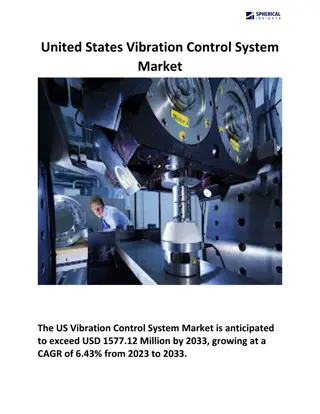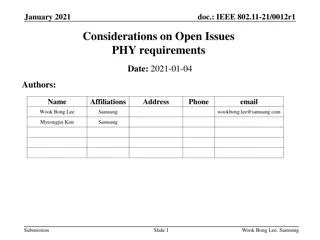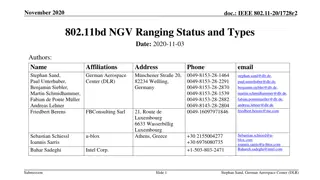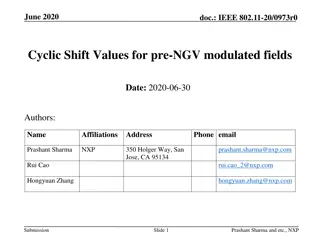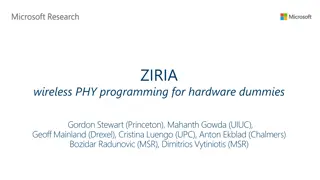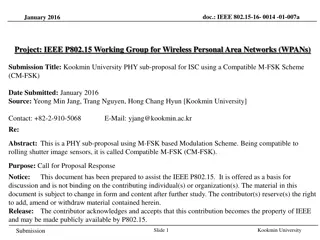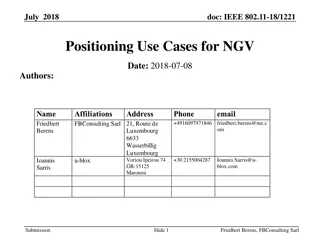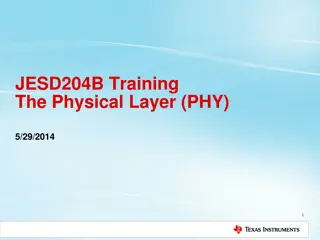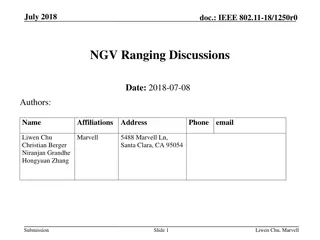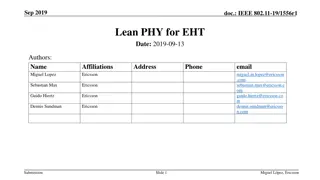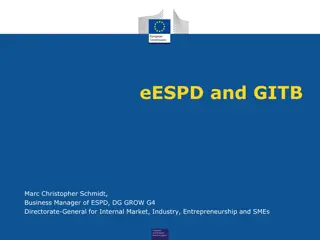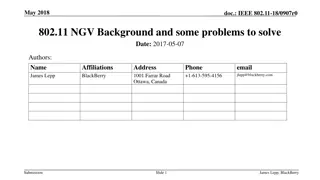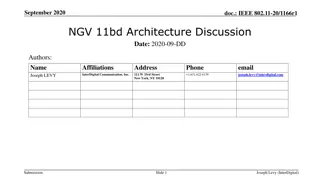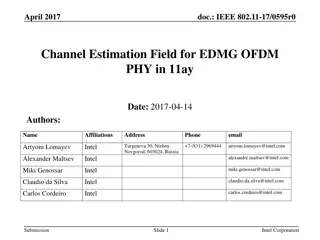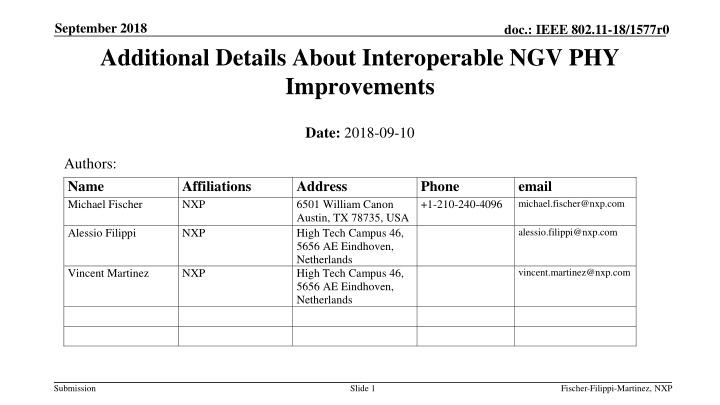
NGV PHY Improvements for IEEE 802.11-18/1577r0 Submission
This submission details additional technical information and simulation results concerning the adaptive message retransmission technique for interoperable NGV PHY improvements as part of IEEE 802.11-18/1577r0. It addresses the necessity for improving PHY performance while ensuring full interoperability with legacy IEEE 802.11p systems, essential in the context of vehicular safety applications. The proposed enhancements encompass transmitter RF improvements, receiver performance enhancements, and waveform design improvements, aiming to enhance link reliability and range with reduced packet error rates.
Uploaded on | 0 Views
Download Presentation

Please find below an Image/Link to download the presentation.
The content on the website is provided AS IS for your information and personal use only. It may not be sold, licensed, or shared on other websites without obtaining consent from the author. If you encounter any issues during the download, it is possible that the publisher has removed the file from their server.
You are allowed to download the files provided on this website for personal or commercial use, subject to the condition that they are used lawfully. All files are the property of their respective owners.
The content on the website is provided AS IS for your information and personal use only. It may not be sold, licensed, or shared on other websites without obtaining consent from the author.
E N D
Presentation Transcript
September 2018 doc.: IEEE 802.11-18/1577r0 Additional Details About Interoperable NGV PHY Improvements Date: 2018-09-10 Authors: Name Michael Fischer Alessio Filippi Affiliations NXP Address 6501 William Canon Austin, TX 78735, USA High Tech Campus 46, 5656 AE Eindhoven, Netherlands High Tech Campus 46, 5656 AE Eindhoven, Netherlands Phone +1-210-240-4096 email michael.fischer@nxp.com alessio.filippi@nxp.com NXP vincent.martinez@nxp.com Vincent Martinez NXP Submission Slide 1 Fischer-Filippi-Martinez, NXP
September 2018 doc.: IEEE 802.11-18/1577r0 Abstract This submission provides additional technical details and new simulation results for the adaptive message retransmission technique for interoperable NGV PHY improvements initially described in submission 11-18/1186, which was presented in July 2018. Submission Slide 2 Fischer-Filippi-Martinez, NXP
September 2018 doc.: IEEE 802.11-18/1577r0 Background Thousands of cars equipped with IEEE 802.11p are already on the road, and several major auto manufacturers have announced massive 802.11p roll-outs [including Toyota, VW, and GM] Improvements to IEEE 802.11p by NGV need to take into account the large number of 802.11p systems that will be in service by the time NGV is adopted and deployed In the 5.9GHz band, NGV needs to be fully interoperable with legacy 802.11p We cannot segment the safety critical V2X applications between legacy and NGV users Millions of lives are at stake Therefore, it is highly desirable to identify and adopt techniques which improve PHY performance while retaining full interoperability with the IEEE 802.11p PHY Submission Slide 3 Fischer-Filippi-Martinez, NXP
September 2018 doc.: IEEE 802.11-18/1577r0 Introduction In July, NXP presented document 11-18/1186, which proposed a series of fully- interoperable PHY improvements, addressing topics such as spectrum emission mask, receiver sensitivity, channel model, Doppler, and, most importantly, better link reliability and/or range through reduction of packet error rate. The proposals are fully interoperable, and the technique for link reliability improvement provides benefits to 802.11p stations as well as NGV stations These improvements can be classified into the following categories: 1. Transmitter RF improvements 2. Receiver performance improvements 3. Waveform design improvements Submission Slide 4 Fischer-Filippi-Martinez, NXP
September 2018 doc.: IEEE 802.11-18/1577r0 Transmitter RF Improvements Adopt a tighter Spectrum Emission Mask (SEM) to reduce transmitter out- of-channel emissions for better Multiple Channel Operation (MCO) Full interoperability with IEEE 802.11p The underlying waveform is not modified Vehicles can exchange messages even if one is using the NGV SEM and the other is using the 802.11p SEM at worst the performance is equal to existing 802.11p Less interference between adjacent channels better SINR increased range & increased safety The standard should control usage of adjacent service channels so that they never reduce performance of the safety channel The more cars with a safer SEM, the safer the MCO Submission Slide 5 Fischer-Filippi-Martinez, NXP
September 2018 doc.: IEEE 802.11-18/1577r0 Receiver Performance Improvements Define receiver improvements which provide better performance on the roads, not just in the lab! Receiver improvements are fully backward-compatible Minimum sensitivity in static channels should be increased by about 6dB NGV should add various multipath fading sensitivity requirements for reliable mobility support (with Doppler values aligned with use cases up to 500 km/h) We propose the use of ITS-G5 V2V channel model for PHY feature acceptance criteria We propose the use of Doppler spectrum offset of 2731 Hz (500 km/h) Submission Slide 6 Fischer-Filippi-Martinez, NXP
September 2018 doc.: IEEE 802.11-18/1577r0 Waveform Design Improvements The new technique we are proposing is adaptive repetition of messages Depending on channel load, the same PPDU is retransmitted zero, one, two, or three times To avoid creating congestion, as channel load, determined by the Channel Busy Ratio measurement, increases, the number of retransmissions is reduced This technique is fully interoperable the individual PPDUs are standard 802.11p transmissions This technique reduces packet error rate for communication from NGV stations to 802.11p stations, not just for communication between NGV stations Submission Slide 7 Fischer-Filippi-Martinez, NXP
September 2018 doc.: IEEE 802.11-18/1577r0 Benefits from Adaptive Repetition of Messages 802.11p stations see each retransmission as a standalone message Performance is improved (1 to 2 dB) due to temporal diversity Duplicated messages will be naturally filtered by application Filtering of duplicate messages is already performed by higher protocol layers no software update needed The initial PPDU and retransmissions can be combined by NGV stations Combining at LLR levels is the recommended technique, but other are possible +4 dB performance boost for 1 retransmission +7 dB performance boost for 3 retransmissions Submission Slide 8 Fischer-Filippi-Martinez, NXP
September 2018 doc.: IEEE 802.11-18/1577r0 Example with Two Repetitions Submission Slide 9 Fischer-Filippi-Martinez, NXP
September 2018 doc.: IEEE 802.11-18/1577r0 Time Gap Between Repeated PPDUs There are several alternatives for the time gap between repeated PPDUs: The recommended approach sends the repetitions as a burst, separated by SIFS SIFS is the minimum gap that maintains interoperability with 802.11p stations Each PPDU burst looks like a single transmission to CCA at other stations within range Another approach is to schedule each repetition as a separate transmission Normal channel access under EDCA is used between each retransmission To bound receiver memory requirements, a time limit needs to be defined, after which the receiver is not required to retain information from older PPDUs Submission Slide 10 Fischer-Filippi-Martinez, NXP
September 2018 doc.: IEEE 802.11-18/1577r0 Simulation Results Summary Simulations with 1 retransmission indicate 0.5-0.8 dB improvement for 802.11p stations and 3-4 dB improvement for NGV stations Simulations with 3 retransmissions indicate 1.0-1.7 dB improvement for 802.11p stations and 6- 8 dB improvement for NGV stations improvement for 802.11p stations improvement for NGV stations 1 retransmission 0.5 dB 3.0 dB 2 retransmissions 0.7 dB 4.7 dB AWGN 3 retransmissions 0.8 dB 6.0 dB 1 retransmission 0.8 dB 4.3 dB G5-HighwayNLOS 886 Hz Doppler 2 retransmissions 1.4 dB 6.7 dB 3 retransmissions 1.7 dB 8.1 dB NXP is working on further simulations and is open to compare results with others Submission Slide 11 Fischer-Filippi-Martinez, NXP
September 2018 doc.: IEEE 802.11-18/1577r0 Simulation Results, Example (a) -3.0 dB -0.5 dB 802.11p with improvement NGV Current 802.11p Submission Slide 12 Fischer-Filippi-Martinez, NXP
September 2018 doc.: IEEE 802.11-18/1577r0 Simulation Results, Example (b) Submission Slide 13 Fischer-Filippi-Martinez, NXP
September 2018 doc.: IEEE 802.11-18/1577r0 Combining of Repeated PPDUs For NGV stations, the substantial performance improvement comes from the combining of the multiple transmission of a message into a combined decoding This allows the receiving station to fully leverage white-noise reduction and fading channel temporal diversity The combining of different transmissions can be performed at different stages of the NGV receiver PHY This includes, but not limited to, joint equalization or LLR generation LLR-level combining is what is typically used in HARQ implementation for 3GPP LTE Submission Slide 14 Fischer-Filippi-Martinez, NXP
September 2018 doc.: IEEE 802.11-18/1577r0 Adaptive Retransmission Control We propose adaptive control of the number of retransmissions (from 0 to 3) based on the measured congestion of the channel, using the Channel Busy Ratio (CBR, as described in ETSI TR 101 613) Measured CBR Number of retransmissions Traffic increase (vs 802.11p) Comment 0 No increase in traffic Congested environment situation. Retransmissions are disabled 0.6 [0.3 0.6[ 0 or 1 (*) x1 to x2 The number of retransmissions is gradually increased as the occupancy of the channel goes down. [0.2 0.3[ 1 x2 [0.15 0.2[ 2 x3 < 0.15 3 x4 (*) Number of retransmissions = 0 or 1 Retransmission = random value with probability of retransmission = p = (0.6-CBR)/0.3 For example, CBR=0.30 p = (0.60-0.30)/0.3 = 0.3/0.3 = 1 For example, CBR=0.15 p = (0.60-0.45)/0.3 = 0.15/0.3 = 0.5 For example, CBR=0.60 p = (0.60-0.60)/0.3 = 0/0.3 = 0 Submission Slide 15 Fischer-Filippi-Martinez, NXP
September 2018 doc.: IEEE 802.11-18/1577r0 Benefits These techniques improve performance while maintaining interoperability, coexistence, backward compatibility, and fairness with 802.11p equipment These techniques provide substantial improvements for communication between NGV stations, while also providing some improvement for communication to and from 802.11p stations that do not implement NGV These techniques do not increase channel load in congested environments These techniques do not require changing higher layers of the ITS protocol stack Submission Slide 16 Fischer-Filippi-Martinez, NXP

